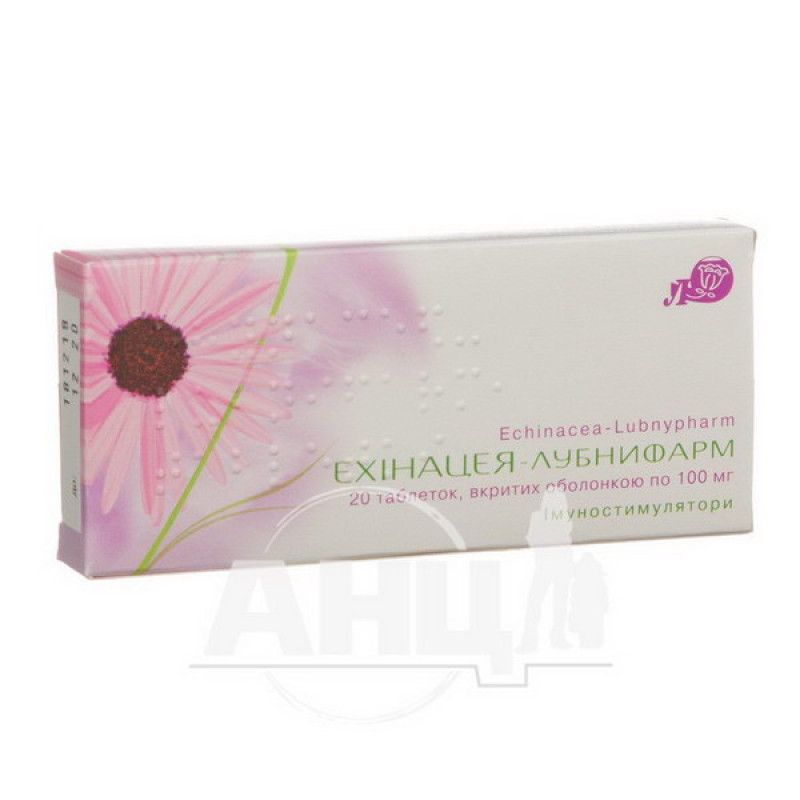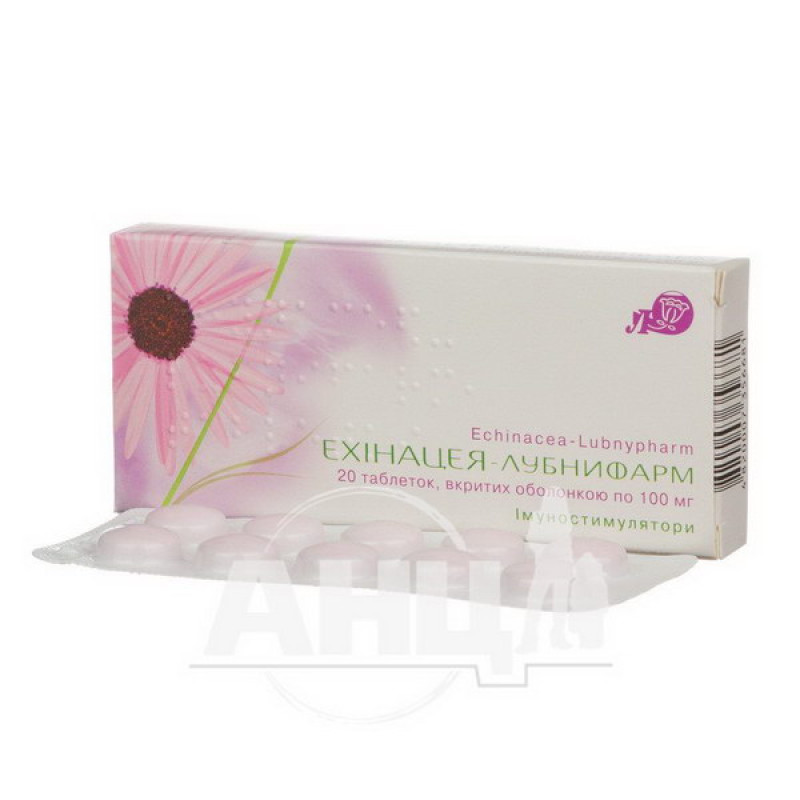Echinacea-Lubnypharm film-coated tablets 100 mg blister No. 20

Translation of the instructions can be
Echinacea-LUBNIPHARMS film-coated tablets 100 mg
Instruction
For medical use of the medicinal product
Echinacea-Lubnypharm
(Echinacea-lubnypharm)
Composition:
Active ingredient: 1 tablet contains echinacea purpurea roots (echinaceae purpureae radix) thick extract (calculated as a content of 9% oxycorrhoic acids) (extractant - ethanol 40% (v/v)) - 100 mg;
Excipients: microcrystalline cellulose; lactose, monohydrate; potato starch; methylcellulose; calcium stearate; sodium starch glycolate (type A); colloidal anhydrous silicon dioxide; hydroxypropylmethylcellulose; candurin silver lustre (mother of pearl); titanium dioxide (E 171); food coloring Red A (E 129).
Dosage form.
The pills are coated.
Main physicochemical properties: solid, regular, round cylinders, the upper and lower surfaces of which are convex, covered with a pink shell, with a smooth surface, on the fracture a light brown core with dark inclusions is visible, surrounded by one continuous layer of shell.
Pharmacotherapeutic group.
Immunostimulants. ATS code l03a x.
Pharmacological properties.
Pharmacodynamics.
Plant biogenic stimulant, which has immunomodulatory and anti-inflammatory effects, stimulates bone marrow circulation, resulting in an increase in the number of leukocytes and cells of the reticuloendothelial system of the spleen. Activates mainly cellular immunity, stimulates the phagocytic activity of macrophages and chemotaxis of granulocytes, promotes the release of cytokines, increases the production of interleukin-1 by macrophages, accelerates the transformation of B-lymphocytes into plasma cells, enhances antibody formation and T-helper activity. Increases the body's nonspecific resistance (including to influenza and herpes pathogens).
Pharmacokinetics.
Well absorbed in the digestive tract. Excreted in urine and feces.
Clinical characteristics.
Indication.
As part of combination therapy for frequent recurrences of infectious diseases of the respiratory and urinary tract.
Contraindication.
Hypersensitivity to the drug or to other asteraceae (chamomile, calendula, dandelion). tuberculosis, rheumatism, systemic connective tissue diseases (collagenoses), multiple sclerosis and other autoimmune diseases (systemic lupus erythematosus), chronic viral diseases, AIDS or HIV infection, neoplasms, primary immunodeficiency, immunosuppression, diseases of the leukocyte blood system (e.g. leukemia, agranulocytosis).
Interaction with other drugs and other types of interactions.
As a result of its immunostimulating effects, echinacea may reduce the effectiveness of drugs that have an immunosuppressive effect.
The drug is not recommended for use simultaneously with drugs with hepatotoxic effects, such as amiodarone, methotrexate, ketoconazole, and steroid drugs.
It is not excluded that the effect may be enhanced or weakened with concomitant use of drugs whose elimination depends on the activity of P450, CYP3A or CYP1A2 isomers.
Application features.
If respiratory diseases have frequent recurrences and prolonged symptoms, manifested by difficulty breathing, fever, sputum mixed with pus or blood, you should consult a doctor.
If symptoms worsen or body temperature increases during treatment, you should consult a doctor immediately.
In case of repeated complaints of urinary tract dysfunction, a medical examination is necessary, and the patient should be under the supervision of a doctor.
Patients with a tendency to allergies should consult a doctor before taking the drug, as there is a risk of anaphylactic reactions.
It is recommended to combine taking the drug with taking vitamins A, E, and C.
The drug contains lactose, so it should not be prescribed to patients with rare hereditary forms of galactose intolerance, lactase deficiency or glucose-galactose malabsorption syndrome.
Use during pregnancy or breastfeeding.
Do not use.
The ability to influence the reaction speed when driving vehicles or other mechanisms.
Given the possible effect of echinacea on the nervous system, the drug should be used with caution when driving or operating other machinery.
Method of administration and doses.
The tablets can be dissolved, chewed or swallowed with liquid. The time of taking the drug does not depend on the time of eating.
Adults and children over 12 years of age are prescribed 1 tablet (100 mg) 2 times a day. The maximum daily dose is 4 tablets (400 mg).
Children from 6 to 12 years old - 1 tablet (100 mg) per day. The maximum daily dose for this age group is 1 tablet (100 mg).
Duration of treatment - 10 days if the drug is taken daily or 20 days if the drug is taken every other day. The maximum duration of taking the drug is no more than 2 weeks (if taken daily). In chronic diseases, the course of treatment can be repeated after 2 - 3 weeks.
Children.
The drug is not recommended for use in children under 6 years of age due to lack of experience with its use.
Overdose.
Symptoms: nausea, vomiting, diarrhea, insomnia, increased excitability of the nervous system.
Treatment: symptomatic therapy, gastric lavage, enterosorbents.
On the part of the immune system: hypersensitivity reactions, including rash, redness of the skin, itching, angioedema, urticaria, Stevens-Johnson syndrome, shortness of breath, bronchospasm with obstruction, anaphylactic shock.
On the part of the respiratory system: difficulty breathing, shortness of breath, bronchospasm with obstruction, bronchial asthma.
From the nervous system: dizziness, sleep disturbances.
Gastrointestinal tract: nausea, vomiting, diarrhea, abdominal pain.
Vascular: decreased blood pressure.
There have been isolated reports of a possible association with autoimmune diseases (disseminated encephalomyelitis, erythema nodosum, immunothrombocytopenia, Evans syndrome, Sjögren-Larsen syndrome with impaired renal tubular function).
With prolonged use (more than 8 weeks), leukopenia may occur.
Expiration date.
2 years.
Storage conditions.
Store in original packaging at a temperature not exceeding 25 degrees Celsius.
Keep out of reach of children.
Packaging.
100 mg tablets No. 20 (10 × 2), No. 30 (10 × 3) in blisters.
Vacation category.
Without a prescription.
Producer.
PJSC Lubnyfarm.
Location of the manufacturer and address of its place of business.
Ukraine, 37500, Poltava region, M lubny, Barvinkovy St., 16.
There are no reviews for this product.
There are no reviews for this product, be the first to leave your review.
No questions about this product, be the first and ask your question.



